History and description
A palace at the site first belonged to Giuseppe Lanza, duca di Camastra, who sold it to the duca di San Donato, who then sold it circa 1724 to Domenico Rosso, 3rd Prince di Cerami. Due to the devastation of the 1693 earthquake, the villa we see likely dates mainly to the reconstruction pursued by the architect Giovanni Battista Vaccarini. Vaccarini also likely designed the entrance portico and the monumental entrance staircase. The son of Domenico Rosso, 4th prince of Cerami, took possession of the house from 1735 to 1768; he was a close friend of the Catanian polymath and antiquarian, Ignazio Paternò Castello, prince of Biscari. It is recorded in a history of Catania, that Domenico gave food to many families and orphans during the famine of 1763.
The building was refurbished in the second half of the 19th century by Carlo Sada, commissioned by the 9th prince of Cerami. One impetus of the refurbishment was to host in January 1881, the king Umberto and the queen Margherita. For the event a frescoed altarpiece depicting the Assumption of the Madonna by Olivio Sozzi was plastered over and painted with a more festive fresco, a copy of Guido Reni's Roman masterpiece of Aurora. The villa passed on the comune of Catania and became a school, with the facility falling into decay, and losing most of the mobile artwork. A 14th-century oil painting depicting the Martyrdom of St Agatha attributed to Giovanni da San Giovanni is now in the city hall.
In 1957, the villa was acquired by the Università di Catania. This was followed by some restoration of the villa garden, and conversion of the large ball-room into the aula magna (large classroom) for the faculty of Jurisprudence. However, from 1962 to 1964, to create offices for the faculty, classrooms, and a library, a modern 5 story glass tower was built in the northwest portion of the property in what had been part of the gardens.
The Baroque portico, rich with sculptural decoration and the Cerami coat of arms, leads to a forecourt where the scuderia (former carriage-house) has been converted to classrooms. Outside of the portal, a formal marble water font was installed for the neighborhood by the Cerami family. [1]

Sicilian Baroque is the distinctive form of Baroque architecture which evolved on the island of Sicily, off the southern coast of Italy, in the 17th and 18th centuries, when it was part of the Spanish Empire. The style is recognisable not only by its typical Baroque curves and flourishes, but also by distinctive grinning masks and putti and a particular flamboyance that has given Sicily a unique architectural identity.

Sant'Anna dei Lombardi,, and also known as Santa Maria di Monte Oliveto, is an ancient church and convent located in piazza Monteoliveto in central Naples, Italy. Across Monteoliveto street from the Fountain in the square is the Renaissance palace of Orsini di Gravina.

Santa Maria in Campitelli or Santa Maria in Portico is a church dedicated to the Virgin Mary on the narrow Piazza di Campitelli in Rione Sant'Angelo, Rome, Italy. The church is served by the Clerics Regular of the Mother of God.
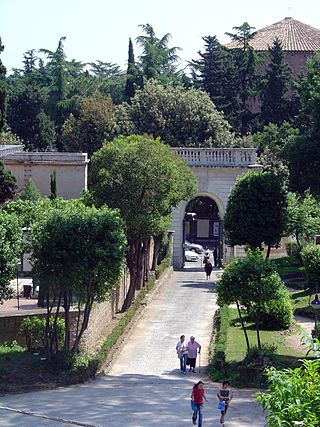
The Villa Celimontana is a villa on the Caelian Hill in Rome, best known for its gardens. Its grounds cover most of the valley between the Aventine Hill and the Caelian.

Pistoia Cathedral, or Cathedral of Saint Zeno is the main religious building of Pistoia, Tuscany, central Italy, located in the Piazza del Duomo in the centre of the city. It is the seat of the Bishop of Pistoia and is dedicated to Saint Zeno of Verona.

Palazzo degli Elefanti is a historical building in Catania, region of Sicily, southern Italy. It currently houses the city's Town Hall. In the past, the prior building was also known as the Palazzo Senatorio or Loggia Senatoria.

San Benedetto is a late-Baroque architecture, Roman Catholic church and former Benedictine monastery in the city Catania, Sicily, southern Italy. The church facade faces Via Crociferi, parallels across via San Benedetto the former-Jesuit church of San Francesco Borgia, and both are about a block south along Crociferi from the church and convent of San Giuliano. Entrance to church and monastery appear to be through Piazza Asmundo #9 near the apse of the church.
San Domenico is a Renaissance and Gothic style, consecrated Roman Catholic church and former monastery. It is located on the corner of Largo Monsignor Muzi and Via Luca Signorelli, and adjacent to the Piazza di San Giovanni in Campo, in the center of Città di Castello, region of Umbria, Italy.
Piazza del Duomo is the main city square in Catania, Italy, flanked by both the centers of civic and religious power.
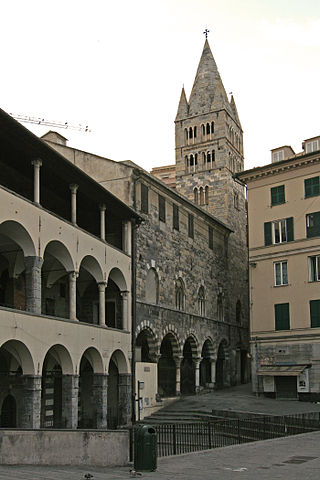
Prè is a neighbourhood in the old town of the Italian city of Genoa. It was one of the six sestieri of ancient Genoa. At present it is part of the Genoa's city I Municipio. Located close to the old harbour, it is likely the best-known neighbourhood of the old town of Genoa.

The Amphitheatre of Catania is a Roman amphitheatre in Catania, Sicily, Southern Italy, built in the Roman Imperial period, probably in the 2nd century AD, on the northern edge of the ancient city at the base of the Montevergine hill. Only a small section of the structure is now visible, below ground level, to the north of Piazza Stesicoro. This area is now the historic centre of the city, but was then on the outskirts of the ancient town and also occupied by the necropolis of Catania. The structure is part of the Parco archeologico greco-romano di Catania.

San Giuliano is a Roman Catholic church and attached convent located on Via Crocifero #36 of Catania, Sicily, southern Italy. It stands across from the Collegio dei Gesuiti, whose church of San Francesco Borgia also faces Crociferi. Two blocks north on Crociferi is the baroque church of San Camillo de Lellis.

Santa Agata al Carcere, sometimes called Santo Carcere or the Carcere church is a Roman Catholic church located on Piazza Santo Carcere #7, in the city of Catania, Sicily, southern Italy. It is one of three nearly adjacent churches venerating St Agatha of Sicily in this neighborhood, the other two being Sant'Agata alla Fornace and Sant'Agata la Vetere.
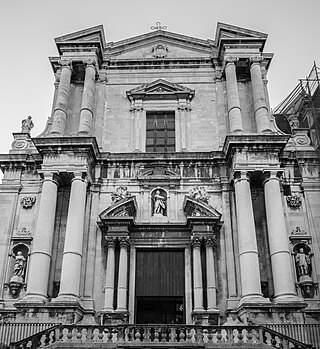
San Francesco Borgia is a Roman Catholic church located on Via Crociferi #7, adjacent to the former Collegio Gesuita, and parallel to San Benedetto, and about a block south on Crociferi of the church and convent of San Giuliano, in the city of Catania, region of Sicily, southern Italy. The church is mainly used for exhibits, but still holds much of the original Jesuit artwork.
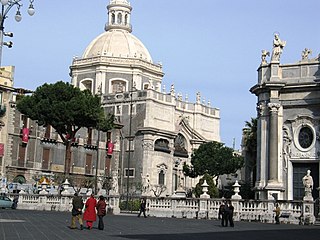
Badia di Sant'Agata or Abbey of St Agatha refers to an 18th-century Roman Catholic church and attached female convent located on Via Vittorio Emanuele #182 in the center of Catania, region of Sicily, southern Italy. The Baroque style church facade is across the street from the left transept of the Cathedral of Catania.

The Palazzo dell'Università or Palazzo Centrale dell'Università di Catania is a monumental palace located in Piazza Universitaria, in the center of the city of Catania, region of Sicily, southern Italy. Since its construction, it has housed the main offices of the University of Catania, and stands across the piazza from the Palazzo San Giuliano, also housing offices of the university. It presently houses the offices of the rector, university offices, the "Giambattista Caruso" Regional Library, and a small museum of geology and archeology.
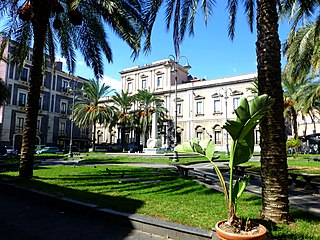
The Palazzo Cutelli is a historic palace, once housing the Collegio Cutelli, now the semiprivate Convitto Cutelli, a boarding school from primary to lyceum grades, located on Via Vittorio Emanuele #56 in central Catania, region of Sicily, Italy.

The Palazzo Paternò del Toscano, also known as the Palazzo del Toscano, is an notable palace in Piazza Stesicoro, in the center of Catania, region of Sicily, southern Italy. The building now houses many shops, but is also used by schools, and for cultural programs. The white stone facade stands before the Monument to Vincenzo Bellini and rises in contrast to the palace across via Aetna, the white and black Palazzo Tezzano.

The Palazzo Gioeni Asmundo is an notable palace located on via Fragalà #10 facing Piazza dell'Università in the center of Catania, region of Sicily, southern Italy. The building, like the two other prominent palaces facing this piazza, now houses offices of the University of Catania.
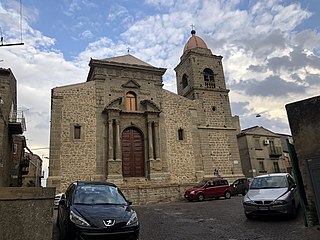
Sant'Antonio Abate is a Baroque-style Roman Catholic church in the town of Cerami, in the province of Enna, region of Sicily, Italy.


















